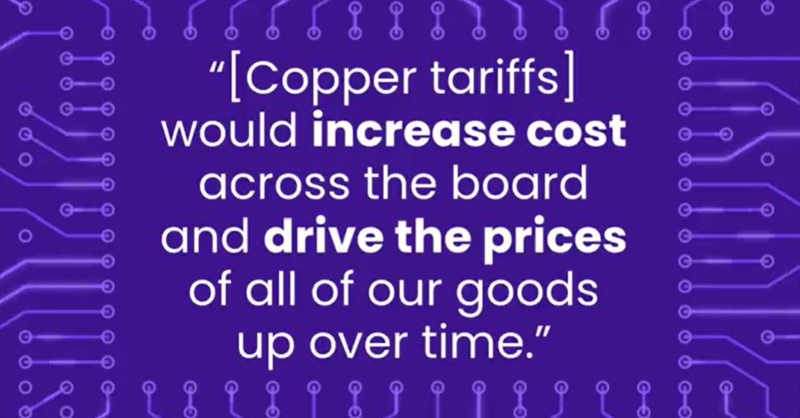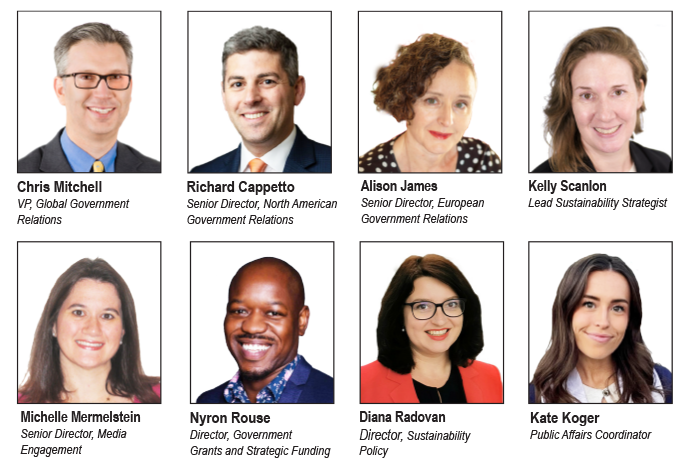 |
Dear [Colleague]:
A flurry of trade activity defined the week, with new deals signaling both relief and risk for electronics manufacturers. A proposed copper tariff continues to spark industry concern as companies brace for potential cost hikes, while our latest industry survey reveals just how deeply those impacts could cut.
In Mexico, momentum continues with new aerospace and auto investments reshaping the manufacturing landscape, and in India, export growth is reshaping supply chains across Asia. Meanwhile, Brussels is focused on streamlining environmental and sustainability rules, with multiple initiatives now open for feedback.
Also in the United States, the Department of Defense’s updated PFAS strategy underscores long-term regulatory and sourcing challenges for critical materials.
Keep reading for the full rundown, and as always, let us know how we can support your advocacy needs.
Chris Mitchell
Vice President, Global Government Relations
The Headlines at a Glance:
TOP NEWS OF THE WEEK
- New Trade Deals Signal Relief and Risk for Electronics Manufacturers
QUOTE OF THE WEEK
- Global Electronics Association Takes Copper Concerns to the White House
UNITED STATES
- Copper Tariff Discussions Raise Cost Concerns for U.S. Manufacturers
MEXICO
- Electronics Manufacturing Footprint Expands Across Mexico
ASIA
- India’s Electronics Exports Reach New Milestone with Global Ripple Effects
- Malaysia Introduces Trade Permit Requirement for U.S.-Origin AI Chips
ENVIRONMENT AND SUSTAINABILITY
- EC Pursues Simplification of Environmental Rules and Circular Economy Act Consultation
- Sustainability Reporting Omnibus Moves Forward in European Parliament
- U.S. Defense Department Releases 2025 PFAS Update; Minnesota Extends Reporting Period
- EFRAG Releases Key Insights from First Wave of CSRD Reports
OTHER HEADLINES IN THE NEWS
- The Wall Street Journal | Legislators Embrace Technology Recycling to Compete with China
- Yahoo! Finance | Easing Trade Tensions Boost Stocks but Chip Stocks Slide
HELP US SPREAD THE WORD ON SOCIAL MEDIA
KEEP IN TOUCH WITH US
 |
New Trade Deals Signal Relief and Risk for Electronics Manufacturers: A wave of trade diplomacy this week brought short-term relief and long-term questions for the global electronics industry. As reported by Global Data, the U.S. finalized a new agreement with Japan that lowers tariffs on semiconductors, battery materials, and select electronics components from 25 percent to 15 percent. U.S. President Donald Trump signaled flexibility with key allies to secure “fair” and “reciprocal” access.
At the same time, easing trade tensions helped lift global markets, with major indexes rebounding on news of potential tariff rollbacks with additional U.S. partners, including the European Union and South Korea, according to Yahoo Finance’s market coverage. Brussels, as reported by Reuters, is finalizing its own deal with the Trump administration while also developing long-term countermeasures focused on digital goods and sustainability-linked trade rules. Mexico also entered talks with the U.S. after President Trump proposed a 30 percent tariff on Mexican imports, set to begin August 1, according to Mexico Industry. With over 80 percent of Mexico’s exports headed to the U.S., the move could trigger widespread supply chain disruptions.
The Global Electronics Association is closely tracking the situation and urging U.S. trade officials to exempt key manufacturing inputs such as semiconductors, PCBs, raw materials, and specialized equipment. These goods are essential to sustaining onshore production, and tariff-related disruptions could undermine the industry's competitiveness. With the new deadline just a week away, electronics manufacturers should prepare for multiple scenarios. Advocacy efforts are ramping up, and your input is invited to help shape our policy recommendations. Contact: Chris Mitchell
 |
 |
“We emphasized the urgent need to revitalize the PCB industry—a foundational pillar of the electronics ecosystem that supports national security, economic competitiveness, and technological leadership. Always grateful for the opportunity to highlight the strategic importance of electronics manufacturing and to advocate for stronger federal support to rebuild U.S. capabilities and capacity.”
— Chris Mitchell, Vice President of Government Relations for the Global Electronics Association, in a LinkedIn post about his recent visit to the White House to discuss the proposed copper tariffs and their potential impact on U.S. printed circuit board fabricators and the broader electronics industry
 |
Ongoing Copper Tariff Discussions Raise Cost Concerns for U.S. Electronics Manufacturers: The copper market remains on edge as U.S. President Donald Trump continues weighing a 50 percent tariff on imported copper, with potential implementation as soon as August 1. This has triggered concern among PCB manufacturers and electronics assemblers who rely heavily on imported copper inputs. The Global Electronics Association recently surveyed U.S. board fabricators and EMS firms to better understand the potential impact, and those findings were presented in a meeting with White House staff this week.
According to the survey, many fabricators anticipate a 10 to 30 percent increase in manufacturing costs if the tariff takes effect, especially for high-copper or high-scrap board types. The blog also explains how tariffs would apply to the full volume of imported copper, even the portion etched or milled away during fabrication. With most electronics-grade copper foil and laminates still sourced from Asia and limited U.S. capacity available, the risk of immediate cost increases is high.
Until we have more clarity, companies should assess their exposure and consider strategies including supply diversification, increased recycling, and potential material substitutions. Contact: Chris Mitchell
 |
Electronics Manufacturing Footprint Expands Across Mexico: New developments across Mexico are reinforcing its role as a strategic manufacturing base for global supply chains. In Baja California, firms like Coast Aluminum, Aleaciones Especiales, and Tuvnord are strengthening the domestic aerospace ecosystem through precision materials, AS9100/AS9120 certifications, and integrated services, as reported by Mexico Industry. These advancements improve local sourcing options for OEMs and Tier‑1 suppliers, offering enhanced lead times and reduced regulatory risk.
In Aguascalientes, industrial parks such as FINSA, Tecnopolo II, and VESTA are attracting record levels of investment in automotive, logistics, and electronics manufacturing, according to Mexico Industry . Meanwhile, Mexico Now reports that South Korean auto supplier SL Corporation has announced a US$45 million investment to build a new facility in San Luis Potosí’s Logistik II Park. The project will double the company’s nearshoring capacity in Mexico and reflects continued foreign interest in the region’s Tier‑1 and Tier‑2 supplier base.
For electronics manufacturers, these trends suggest growing opportunities to integrate with certified suppliers, scale production closer to North American end markets, and leverage established infrastructure for future growth. Contact: Lorena Villanueva
 |
India’s Electronics Exports Reach New Milestone with Global Ripple Effects: India’s electronics exports surpassed $40 billion in FY2024, marking a 47 percent year-over-year increase, according to official figures reported by MSN India and The Economic Times. Top destinations included the United States, United Arab Emirates, and China. Union IT Minister Ashwini Vaishnaw attributed the momentum to manufacturing growth under India’s Production-Linked Incentive (PLI) scheme, particularly in mobile phones, IT hardware, and components.
As has been reported, India’s government is now targeting expanded capacity in high-tech segments such as semiconductor manufacturing and automotive electronics. These developments are contributing to a shifting global landscape, as companies evaluate new supply chain hubs and cost structures across Asia. Contact: Gaurab Majumdar
Malaysia Introduces Trade Permit Requirement for U.S.-Origin AI Chips: Malaysia’s Ministry of Investment, Trade and Industry (MITI) announced last week that imports of artificial intelligence (AI) chips from the United States will now require a special trade permit. As reported by Reuters, the move is intended to close regulatory gaps, ensure alignment with Malaysia’s strategic trade controls, and support national security and foreign policy objectives. MITI clarified that the new requirement is not a ban but a mechanism to improve oversight and transparency in high-tech trade.
Global electronics companies operating in Malaysia or relying on AI chip supply chains should assess the potential compliance impacts. With so much attention these days on AI supply chains, could this and similar government actions become a trend? Let us know if this impacts your company. Contact: Gaurab Majumdar
 |
EC Pursues Simplification of Environmental Rules and Launches Circular Economy Act Consultation: The European Commission has opened a new call for evidence aimed at simplifying environmental compliance across several key regulatory frameworks, including industrial emissions, waste, and circular economy rules. According to the Commission, the planned “environmental omnibus” proposal, which is expected in Q4 2025, may include streamlining of reporting obligations, digitalisation of compliance processes, and potential changes to extended producer responsibility rules. Feedback is being collected through the Have Your Say portal until September 10, and the Global Electronics Association is seeking member input for a coordinated industry response.
Separately, a public consultation on the forthcoming Circular Economy Act will launch shortly and remain open for three months. Members are encouraged to share input for inclusion in the association’s official comments. Contact: Diana Radovan
Sustainability Reporting Omnibus Moves Forward in European Parliament: Parliamentary negotiations are underway on the European Commission’s Omnibus I Simplification Package. The commission proposed changes to the Corporate Sustainability Reporting Directive (CSRD) and the Corporate Sustainability Due Diligence Directive (CSDDD) back in February. The parliament’s Legal Affairs Committee (JURI) on July 15 published its proposed amendments so far on July 15 and will adopt its position by October 13, ahead of a plenary vote planned for November. The full legislative process could extend into late 2025, pending trilogue negotiations, i.e., three-way negotiations between the European Parliament, the Council of the European Union, and the European Commission. The Global Electronics Association is actively reviewing the amendments and seeking member input for a consolidated industry response.
In a parallel yet related process, EFRAG will submit revised European Sustainability Reporting Standards (ESRS) to the European Commission by November 30. Contact: Diana Radovan
U.S. Defense Department Releases 2025 PFAS Update; Minnesota Extends Reporting Period: The U.S. Department of Defense has published its 2025 Update on Critical PFAS Uses, expanding on its 2023 baseline and highlighting growing civil-military dependencies on fluorochemicals. According to the report, mission-critical applications now include textiles, barriers, coatings, batteries, and medical devices, many of which have no current substitutes. The DoD warns that “structural” definitions of PFAS, when applied without toxicity data, are fueling regulatory fragmentation and supply chain disruption. The agency outlines a phased strategy to maintain defense readiness while gradually transitioning to safer alternatives, a process expected to take decades.
Separately, the Minnesota Pollution Control Agency announced an extension of its PFAS reporting deadline for intentionally added substances in products from January 1 to July 1, 2026. As this date now overlaps with the EPA’s TSCA Section 8(a)(7) PFAS reporting period, manufacturers will need to prepare two parallel submissions, each with partially different data requirements and PFAS definitions. Contact: Diana Radovan
EFRAG Releases Key Insights from First Wave of CSRD Reports: EFRAG has published its analysis of 656 initial corporate sustainability reports filed under the Corporate Sustainability Reporting Directive (CSRD). As summarized in EFRAG - ESRS Reporting Insights, the average report length was 115 pages, with significant variation by country and sector. High-level structure was generally similar, supporting comparability across disclosures. However, gaps remain. Only 10 percent of companies reported on all 10 ESRS topical standards, and just 20 percent consulted unions in their double materiality assessments. Climate transition plans were reported by 55 percent of companies, though formats varied. Underreported areas included biodiversity, internal carbon pricing, and human rights incidents. Members are encouraged to review the full findings. Contact: Diana Radovan
 |
 The Global Electronics Association addresses the threats of copper tariffs. |
 Check out the latest edition of the Global Electronics Association’s Community magazine. |
KEEP IN TOUCH WITH US Meet Our Government Relations Team: Whether it is engaging with policymakers in the Americas, Europe, or Asia, the Global Electronics Association Government Relations (GR) Team works to educate, inform, and influence policymakers on policies that affect our industry. Our success depends on active support and participation from attentive people like you!
Peruse our global Advocacy pages on electronics.org and follow the links to information about our work in North America, Europe, and Asia. Subscribe to the Global Advocacy Report: If you are a member of the Global Electronics Association, manage your e-mail preferences and opt in to receive all “Advocacy” updates. If you are not a member — or if you are not sure — please send a note to friends@electronics.org, and our staff will add you to the list. See prior editions of Global Advocacy Report. Please contact one of us via the links above if you have any questions or insights to share! |

